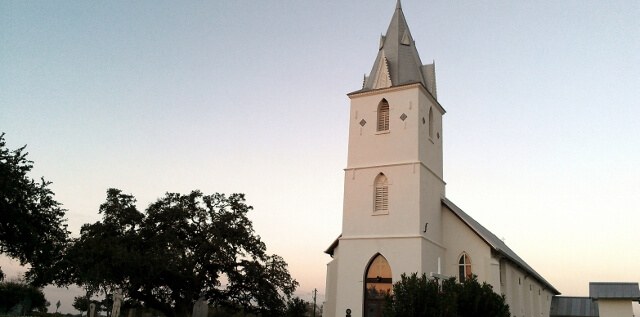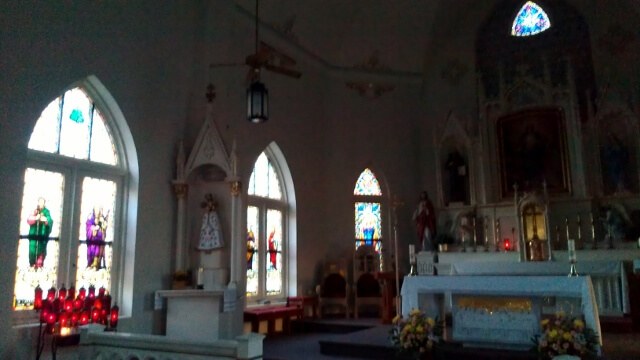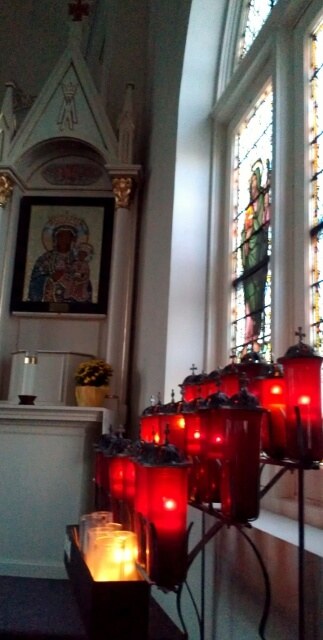It was so quiet at sunset in Panna Maria.
Since I’d turned off of the main road with all of that Eagle Ford shale fracking truck traffic, it was just me, a few birds and a slight breeze. Hours earlier, I’d looked at a map to decide which route would take me back home from a speaking engagement, and it boiled down to roughly five hours with two options:
A) Interstate and crashing boredom – but the fastest way – or,
B) Some Interstate to start and at the end, with small roads in between that held promise.
You know which option I chose, right? Especially when someone earlier that day had said, “Well, there’s really nothing to see the whole way back, and not any good side roads, except one of our visitors found a Polish settlement somewhere in there….”
A little Googling and scanning a Texas Independence Trail heritage region brochure turned up Panna Maria, and now here I was in front of the Immaculate Conception church that the Poles built in 1878. It replaced the first one they’d built back in 1855 when Father Leopold Moczygemba and families from Upper Silesia made Panna Maria the first permanent Polish settlement in the United States.
Of course I knew about all of the Germans and Czechs who came to Texas to settle, and there are even Norwegians in Clifton, Texas, but I never knew that Poles had grabbed a Lone Star foothold as well.
As I parked my car by the church, a couple came out and told me that it was pretty inside and that it was OK to go in and look. Although I’m not of any particular faith group, I enjoy visiting quiet, contemplative places when life gets too crazy (which is, oh, seemingly all the time) so I pushed open the entry door, walked up front and sat in a pew.
It’s a bright, fresh white inside, with windows and plaques that honor both Catholic saints and stalwart church members over the years.
There are two side altars, both with candles gleaming in dark red votives.
One is for Saint Ann, with a statue that is a copy of one on the Mount of St. Ann back in Poland.
The other is a mosaic image of Our Lady of Czestochowa, often called the Black Madonna; it was a gift from President Johnson in 1966 to commemorate the millennium of Poland’s Christianity.
It was obviously a huge deal when the Polish-born Pope John Paul II visited Panna Maria in September 1987. Part of his comments are on a plaque with a statue outside:
“In Poland, Panna Maria, Texas is very famous. Everyone knows of Panna Maria and those first Polish immigrants who responded to the call of their pastor and spiritual leader, Father Leopold Moczygemba. All of our great American Polonia credits its origin to you, Panna Maria, as the first nest built on American soil by Polish immigrants, inspiring others to follow in your footsteps.”
It looks like this is not a tottering community with only a few senior citizens left, either.
A glance at the latest historical society newsletter (available in the church foyer) covers the departure of their pastor, Father Mariusz Lazarek, who was honored with a going-away party that was “well-attended and everyone enjoyed a meal of BBQ….” and the welcome of Father Wieslalw Iwaniec who “is originally from Poland and came to Texas in 1989.”
There are announcements about the upcoming Homecoming Turkey Dinner (“We serve until we run out – last year we made more dressing and baked more turkeys and we still ran out around noon”) plus notes about kids taking their first Communion, the availability of Panna Maria T-shirts “in many sizes….as well as rosaries of all prices” and some fascinating transcriptions of a few letters written by the original settlers and sent back to relatives in the Polish village of P?u?nica.
One letter speaks to cattle raising and types of wheat, and includes this confident guidance to the folks back home:
“If you have money, you can keep even one thousand head of cattle, as Americans do. You can plant cotton, which is very expensive and I, Johan Moczigemba, plan to grow it….I have six head of cattle, one mare in foal, nine [pigs] and ninety chickens.”
All this, on a route home where it looked like there was nothing to see….
If you like this post, please consider subscribing to the blog via RSS feed or by email – the email signup text link is at the top of the right sidebar above our Facebook Page link. Thanks!




